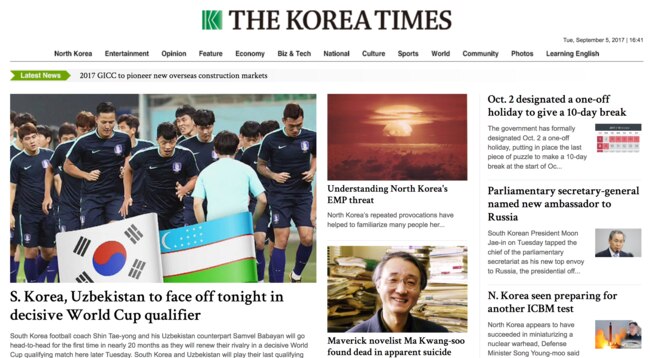The South Koreans are cool as ice, so why are we sweating?
IF WAR with North Korea is really coming, why aren’t the people of Seoul freaking out? Something doesn't add up.
Economy
Don't miss out on the headlines from Economy. Followed categories will be added to My News.
ON WEDNESDAY, after another long day of reading non-stop articles about the pending threat to the world from the nuclear armed rogue state of North Korea, I got to feeling worried for the people of Seoul, South Korea.
With President Trump goading North Korea and Kim Jong-un goading President Trump, it must be a pretty frightening time to live there, I figured.
What I learned next surprised me.
South Korea is a pretty small country and its capital is located in the northern part, really not far from the border with North Korea. The city of about 10 million people is about an hour’s drive from the demilitarised zone that separates the two countries.
North Korea claims to have nuclear weapons that could reach America. That may be true, but their ability to wreak havoc on South Korea is undoubtable, nukes or not.
President Trump’s former strategist Steve Bannon gave his sense of what a major conflict might look like in an interview a few weeks back.
“Ten million people in Seoul,” Bannon said, could “die in the first 30 minutes from conventional weapons.”
Those poor South Koreans must be terrified, I thought. If I was them I would be trying to escape the danger zone. I decided to check the price of flights out of Seoul to see if they had been bid up to crazy levels amid a mad scramble for safety.
The search was a flop. You can fly from Seoul to Shanghai (a two hour flight) for just $184, according to Google Flights.
You can get all the way across the Pacific to LA for just $655. Peanuts. Flights going back the other way cost more: It is actually more expensive to fly into Seoul than to escape it! The panic I expected to find is conspicuously absent.
It got me thinking. If they’re not panicking, why are we?
When I opened the Korea Times the other day, the top story was about their national Soccer team taking on Uzbekistan in World Cup qualification.

The World Cup is not until 2018. If South Korea is eradicated in a major nuclear blast later this year, then there will be no team to take the field in Russia. (Incidentally this could be good news for the hapless Socceroos, who are on the brink of missing qualification for next year’s World Cup, but luckily our boys have no sway over geopolitical conflict.)
Other ways you could look for South Korean panic also come up blank. Their stock market has dipped slightly since a peak in July, but it rose around 1 per cent on Thursday and is about 15 per cent higher than a year earlier.
If South Korea is razed those stocks will be an exceptionally bad buy. But nobody seems to really think it will be.
And on social media? Nobody in Seoul seems to be posting pics of them digging nuclear bunkers or stockpiling bottled water. It looks suspiciously like life goes on as normal.
Which involves a lot of eating:
And drinking:
And obsessing over somebody called Jimin. Jimin, I have learned, is a singer with K-pop band BTS. (Their name translates as the bulletproof boyscouts.) A sort of Korean Bieber, he exerts a pull on Korean fans far, far in excess of what the bemused outside observer could reasonably expect.)
Park Jimin posts are outstripping Kim Jong-un posts by about a million to one, as far as I can see.
So while the west beats itself into a lather, live reports from Seoul ring with total nonchalance.
You'd have no idea nuke tests were going off here in Seoul. Very calm indeed, as usual. pic.twitter.com/qwoRpFCXPQ
— Chad O'Carroll (@chadocl) September 3, 2017
Here in #Seoul, on the front lines of a possible #war, life goes on as usual. No panic, no fear, just another day with our nutty neighbors.
— Stephen Poirier (@Stephenpoirier1) September 4, 2017
The Republic of Korea (South) and The Democratic People’s Republic of Korea (North) are still technically at war (no armistice was ever signed at the end of the Korean conflict).
The two countries have a single major difference: One adopted a market economy and has zoomed ahead in terms of wealth. The other remains riven with malnutrition thanks to the privations of a communist dictatorship.
(South Korean fathers may roll their eyes as their daughters swoon for Jimin but it’s better than seeing them collapse from starvation.)
Despite the ideological and ensuing cultural divides, there is a great deal the two Koreas retain in common. They share a language and a culture. Many families are split across the two nations.
If anyone has insight into what is going on in North Korea, it is probably the South Koreans.
If they’re not panicking, maybe we shouldn’t be either.
Jason Murphy is an economist. He publishes the blog Thomas The Thinkengine. Follow Jason on Twitter @Jasemurphy
Originally published as The South Koreans are cool as ice, so why are we sweating?



